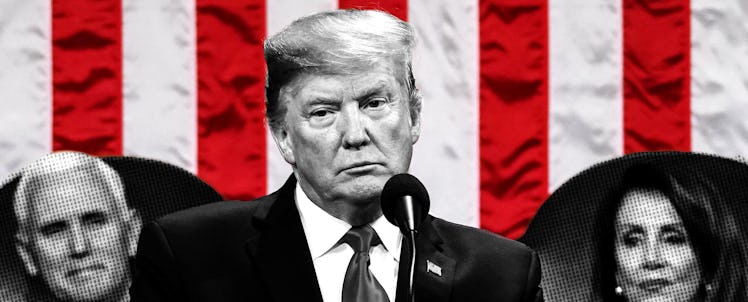Trump’s State of the Union Paid Family Leave Proposal is an Exciting Disaster
If Trump wants to be a champion for new parents, that's fantastic. But his plan as it stands is half-baked.

On Tuesday night, President Trump addressed Congress and the American people. In the State of the Union address, Trump articulated (or reiterated) his views on the so-called immigration “crisis” at the southern border, the fall of the Venezuelan regime, the need for oil production, and the government’s relationship with American parents. Notably, Trump came out strongly for a national paid family leave law, legislation that exists in some form in almost every developed country. It was not a new idea, but the fact that it was highlighted as a priority on a national stage was and is significant.
Trump’s paid family leave plan, which he touted on both the campaign trail and included in his 2018 budget request, is nothing new (though he told congress it was). It has long been part of Ivanka Trump’s portfolio and her talking points. It’s also a good idea. Paid family leave, as per the White House’s statement post-SOTU, “is an investment in our future that will strengthen family bonds and improve the financial stability of American families.”
Paid family leave, when offered, generally results in a workforce with less turnover, helps close the wage gap, and increases productivity post-leave. More than 20 studies have found that paid family leave enormously benefits the health of both infants and their moms. It can even reduce infant mortality by 10 percent because it significantly increases the likelihood that infants get in front of a doctor for vaccinations and well-care visits while increasing the period of breastfeeding. Leave also decreases rates of depression in new parents by almost 20 percent. It is a good thing and the Trump administration’s support is meaningful.
But nascent versions of his proposal — six weeks of paid family leave for employers who don’t already offer it without raising revenue — have already stalled in Congress, and for good reason. Senator Marco Rubio of Florida floated an Ivanka-backed plan to offer paid family leave by letting parents dip into their Social Security and retirement-funds. This seemed generous, but actually asked parents to choose between retirement and post-partum spending. Similarly, Trump’s proposed plan would dip into state coffers of unemployment insurance, allegedly through eliminating fraud and waste in unemployment insurance agencies. This plan, which has been incubating since 2017, relies on funds that remain thin in the wake of the Great Recession.
A report by The Center for Law and Social Policy (CLASP), a non-profit organization that looks at policy solutions that work for low-income people, found that Trump’s version of paid family leave would not be sustainable and also would fail to address workers’ needs. Not only does his plan leave out any family caregiving like caring for an ill spouse or child, it also leaves out medical leave for workers who are seriously ill, or any provisions for caregiving solutions needed due to Military deployment. There is no dedicated federal funding to the plan, and because unemployment insurance coffers are so empty right now, it would cut unemployment benefits to people living in those states. Unemployment taxes, generally paid by employers, would be cut in this proposal and would likely pit the unemployed against parents of new babies. “Under the Trump plan, parents might get a few weeks of paid leave when a child is born, but not be able to keep a roof over that child’s head if they lose their job,” the report says. Trump’s plan provides for six weeks of paid family leave, which is would represent a great start, but just a start. In 2015, Senator Kristen Gillibrand introduced the Family and Medical Insurance Leave Act, the FAMILY Act, which relies on a payroll tax that is funded by employees and employers respectively. That bill dictates for all workers contributing to Social Security get 66 percent of their wages (up to 1,000 dollars a week) for up to twelve weeks. It has gone nowhere. Currently, the Family and Medical Leave Act of 1993 provides for 12 weeks of unpaid, job protected leave all the people covered under Trump’s plan.
The reason Senator Gillibrand’s bill hasn’t moved is the same reason paid family leave can be a thorny issue despite being popular with, well, everyone: Any sustainable program will need to be funded with raised revenue. That means taxes.
If Trump wants to help American families, he’ll need to get a bit more serious about levying taxes on corporations or the wealthy, who are having a better tax season this year than the middle class. He also may not want to conflate a potentially bipartisan issue like parental leave with advocacy for school choice or against reproductive rights, as he did in the address and the White House has done in subsequent statements. Paid family leave is an achievable win for the Trump administration, but you can’t borrow from Peter to pay Paul if Peter is pissed at you. And that’s where things stand.
This article was originally published on